RBSE Solutions for Class 7 Science Chapter 14 Electric Current and its Effects
Rajasthan Board RBSE Solutions for Class 7 Science Chapter 14 Electric Current and its Effects Textbook Exercise Questions and Answers.
Rajasthan Board RBSE Solutions for Class 7 Science in Hindi Medium & English Medium are part of RBSE Solutions for Class 7. Students can also read RBSE Class 7 Science Important Questions for exam preparation. Students can also go through RBSE Class 7 Science Notes to understand and remember the concepts easily. The class 7 science chapter 4 heat extra questions are curated with the aim of boosting confidence among students.
RBSE Class 7 Science Solutions Chapter 14 Electric Current and its Effects
RBSE Class 7 Science Electric Current and its Effects InText Questions and Answers
Page .162
Question 1.
Paheli and Boojho wonder whether the batteries used in tractors, trucks and inverters are also made from cells. Then why is it called a battery? Can you help them to find the answer to this question?
Answer:
Cell is the smallest unit of battery. Combination of two or more cells is called a battery. The batteries used in tractors, trucks and inverters contain about 4 - 6 cells.

Page 164
Question 2.
Boojho could not see elements in an electric iron. Paheli told him that electrical appliances, such as immersion heaters, hot plates, irons, geysers, electric kettles, hair dryers have elements inside them. Have you ever seen the element in any appliance?
Answer:
Yes, we have seen the element inside many other electric equipments like electric heaters, electric kettles etc. The element is in the coiled form, it takes the current from the source and heats up the coil inside it. Thus, it serves the purpose of heating up due to electric current.
RBSE Class 7 Science Electric Current and its Effects Textbook Questions and Answers
Question 1.
Draw in your notebook the symbols to represent the following components of electrical circuits. Connecting wires, switch in the OFF position, bulb, cell, switch in the ON position and battery.
Answer:


Question 2.
Draw the circuit diagram to represent the circuit shown in figure:
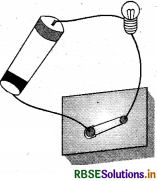
Answer:

Question 3.
Figure shows four cells fixed on a board. Draw lines to indicate how you will connect their terminals with wires to make a battery of four cells:
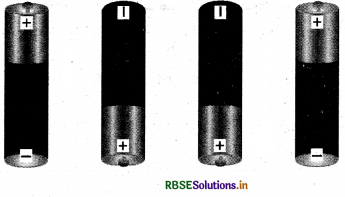
Answer:
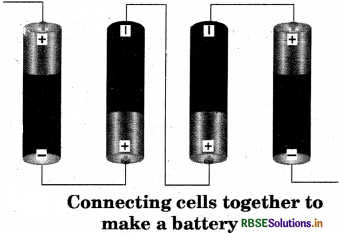
Question 4.
The bulb in the circuit shown in figure does not glow. Can you identify the problem? Make necessary changes in the circuit to make the bulb glow.
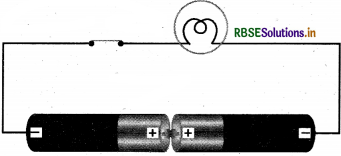
Answer:
Bulb in the circuit is not glowing because positive terminal of one cell is connected to the positive terminal of another. We will connect negative terminal of one cell to the positive terminal of another to make the bulb glow.
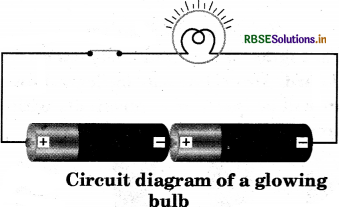
Question 5.
Name any two effects of electric current.
Answer:
Two effects of electric current are:
(a) Magnetic effects of electric current.
(b) Heating effects of electric current.
Question 6.
When the current is switched on through a wire, a compass needle kept nearby gets deflected from its north - south position. Explain.
Answer:
When current is passed through the wire, it deflects the compass near it from its north - south position like a magnet. This is called magnetic effect of the current. When electric current is passed through wire then compass needle behaves as magnet. Thus, it shows deflection from its N - S position. But after switching off the electric switch, it comes back to its original position.
Question 7.
Will the compass needle show deflection when the switch in the circuit shown by figure is closed?
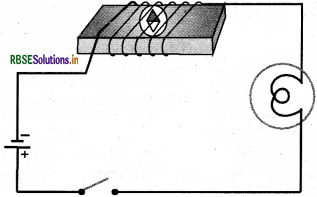
Answer:
No, the needle will not show any deflection when switch is closed as there is no source of electric current such as cell or battery in the circuit.
Question 8.
Fill in the blanks
(a) Longer line in the symbol for cell represents its .............................. terminal.
(b) The combination of two or more cells is called a ..............................
(c) When current is switched ‘ON’ in a room heater, it ..............................
(d) The safety device based on heating effect of electric current is called a ..............................
Answer:
(a) positive
(b) battery
(c) becomes red hot and emits heat
(d) fuse.
Question 9.
Mark 'T' if the statement is True and ‘F’ it is False:
(a) To make a battery of two cells, the negative terminal of one cell is connected to the negative terminal of the other cell. (T/F)
(b) When the electric current through the fuse exceeds a certain limit, the fuse wire melts and breaks. (T/F)
(c) An electromagnet does not attract a piece of iron. (T/F)
(d) An electric bell has an electro - magnet. (T/F)
Answer:
(a) False
(b) True
(c) False
(d) True.

Question 10.
Do you think an electromagnet can be used for separating plastic bags from a garbage heap? Explain.
Answer:
No, it will not collect plastic as they are not attracted to the electromagnet. Plastic bags are not the magnetic material. Only magnetic materials like iron get attracted to the electromagnet.
Question 11.
An electrician is carrying out some repairs in your house. He wants to replace a fuse by a piece of wire. Would you agree? Give reasons for your response.
Answer:
No, I would not agree because an 'ordinary wire cannot replace fuse wire. Fuse wire has low melting point which melts on the passage of high current, thus breaking the circuit and preventing possible fires.
Question 12.
Zubeda made an electric circuit using a cell holder shown in figure, a switch and a bulb. When she put the switch in the ‘ON’ position, the bulb did not glow. Help Zubeda in identifying the possible defects in the circuit.
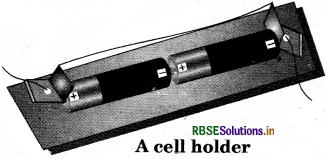
Answer:
The possible defects in the circuit are as follows:
(a) Connecting wires may be loose.
(b) Filament of the bulb may be broken.
(c) Chemicals in the cell may be already used up.
(d) The positive terminal of one cell is not connected to the negative terminal.
(e) The switch is not closed properly.
Question 13.
In the circuit shown in figure:
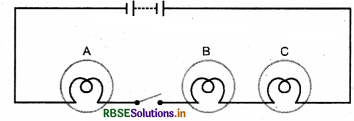
(i) Would any of the bulbs glow when the switch is in the ‘OFF’ position?
(ii) What will be the order in which the bulbs A, B, and C will glow when the switch is moved to the ‘ON’ position?
Answer:
(i) No, bulb will not glow.
(ii) All bulbs will glow simultaneously.

- RBSE Class 7 Science Notes in Hindi & English Medium Pdf Download
- RBSE Class 7 Science Important Questions in Hindi Medium & English Medium
- RBSE Solutions for Class 7 Science in Hindi Medium & English Medium
- RBSE Class 7 Science Important Questions Chapter 1 Nutrition in Plants
- RBSE Class 7 Science Notes Chapter 1 Nutrition in Plants
- RBSE Class 7 Science Important Questions Chapter 14 Electric Current and its Effects
- RBSE Class 7 Science Important Questions Chapter 13 Motion and Time
- RBSE Class 7 Science Important Questions Chapter 2 Nutrition in Animals
- RBSE Class 6 Science Notes Chapter 8 शरीर में गति
- RBSE Class 7 Science Notes Chapter 18 Wastewater Story
- RBSE Class 7 Science Notes Chapter 17 Forests: Our Lifeline